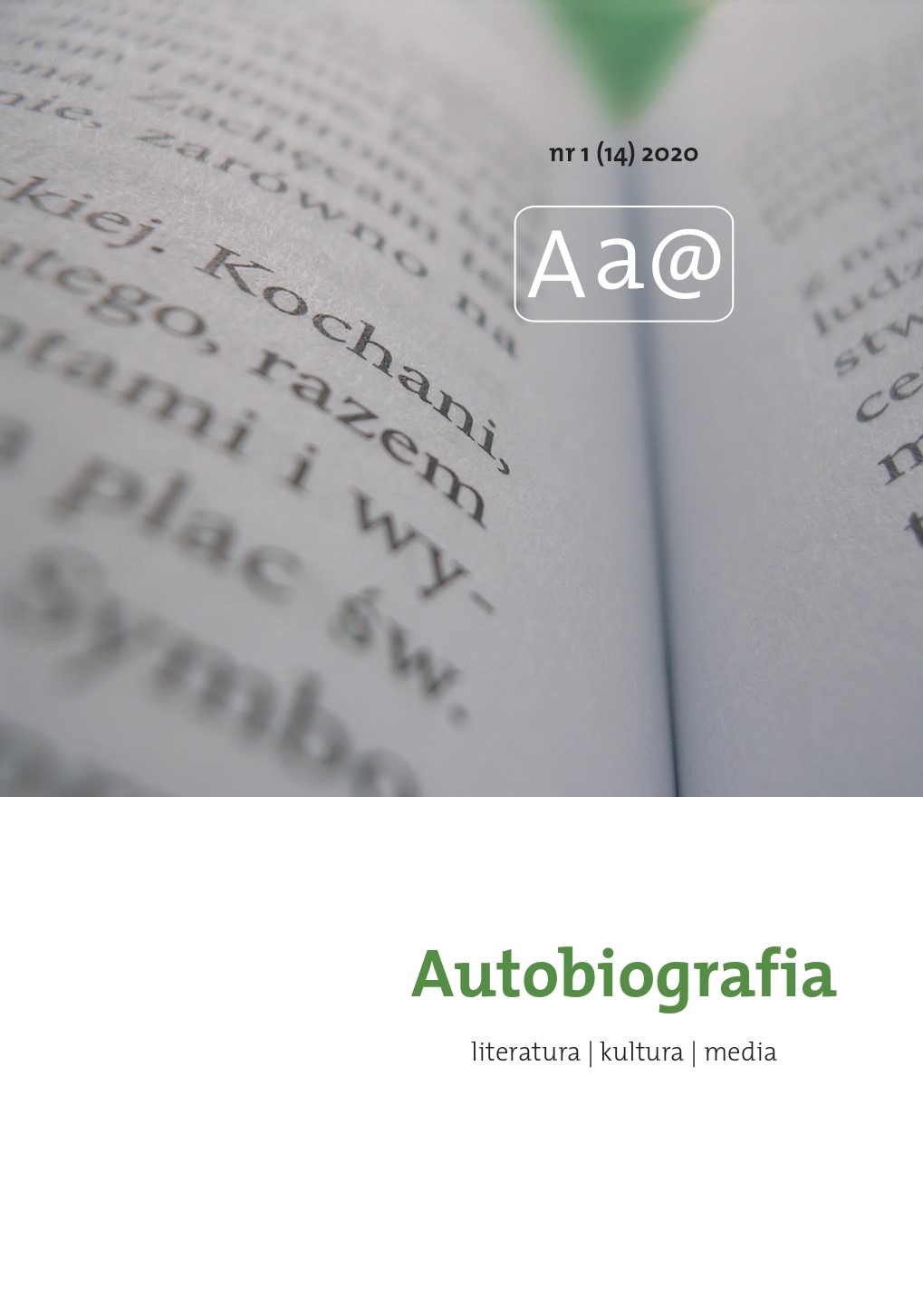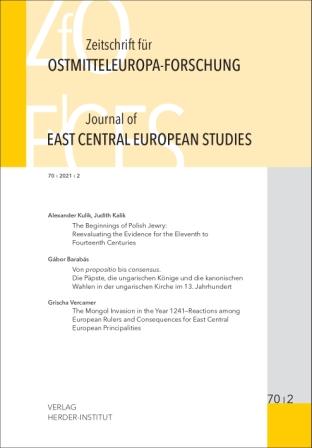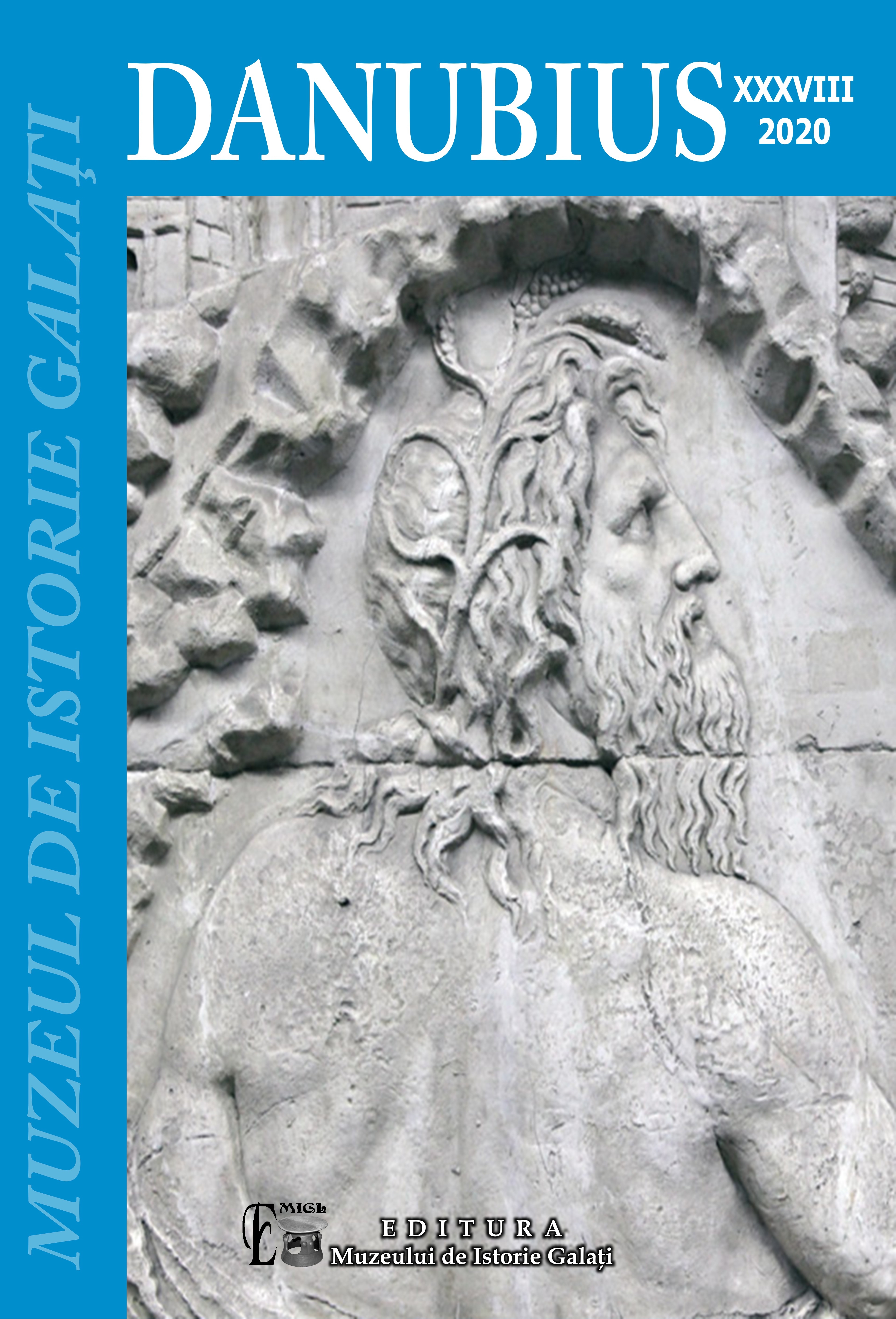
We kindly inform you that, as long as the subject affiliation of our 300.000+ articles is in progress, you might get unsufficient or no results on your third level or second level search. In this case, please broaden your search criteria.


This text introduces a collection of articles which seek to interpret Jewish ego documents and testimonies, broadly defined. Reading these documents facilitates a process of uncovering intimate threads and problematizing Jewish biographies.
More...
After escaping the German mass killing facility in Sobibór on 14 October 1943, Dov Freiberg and Semyon Rozenfeld survived in hiding near Chelm until the arrival of the Red Army in July 1944. In 1945, Freiberg testified before the Central Jewish Historical Commission, and in 1988, he published his much more extensive memoirs To Survive Sobibor. Both texts cover the period of hiding, during which Freiberg, Rozenfeld and the brothers Dawid and Józef Serczuk were taken in by two women. The two sources reveal an episode of male sexual barter, as the male group established rational relationships with the two women in order to stabilize a precarious situation. By comparing both of Freiberg’s texts, it becomes clear that so-called late testimonies are rich and unjustly underrated source-material.
More...
This article reexamines the evidence of Jewish presence in Poland from the eleventh to the fourteenth centuries in connection with problems of origins, periodization, and localization of Jewish settlement in Poland. It deals inter alia with questions regarding the balance between Jewish and Christian evidence, as well as with reports of Jewish presence from neighboring areas of Eastern Europe such as Kievan Rus’. The reevaluation of evidence on medieval Polish Jews helps to illuminate the origins of eastern Ashkenazi Jewry, as well as to clarify diverse aspects of the history of early Eastern Europe. Thus, for example, among the most important general conclusions is the lack of continuity across three waves of Jewish migration and settlement in Poland. Since most Polish Jews were descendants of the third wave of Jewish migration into Poland, there is little doubt that the vast majority of them came from Germany and Bohemia, mostly via Silesia. We can also reliably conjecture that the Jewish population of southwestern Rus’—whatever its origins (possibly also at least partially Ashkenazi) and size (possibly reduced by the Mongol conquest)— came to be integrated with immigrants from the west due to the eastward expansion of Lithuania and Poland during the thirteenth and fourteenth centuries. Thus, most modern Ashkenazi Jewry must go back to the melding of these two communities.
More...
The Ministry of External Affairs owns an important fund of diplomatic documents (more than 8,000 linear meters of archives), issued by the central administration, by diplomatic missions and by Romanian consulates from abroad. The files are organized according to the problem they deal with (from 1 to 105), as they were classified in the Archives Nomenclatory created in 1909, according to the Austrian pattern. This system is in use even today, for classifying most of the archival funds. According to this system, we pay a special attention to Problem no. 33 – Jews Related Issues (1900-1948).The study aims at analysing the documents pertaining to this problem, which deal with the emigration of the Romanian Jews, at the end of the XIX-th century and the beginning of the next one.
More...
Review of: Jan Kieniewicz - Henryk Szlajfer, Współtwórcy atlantyckiego świata: Nowi chrześcijanie i Żydzi w gospodarce kolonialnej Ameryki Łacińskiej XVI–XVII wieku [Co-creators of the Atlantic World: New Christians and Jews in the Colonial Economy of Latin America in the Sixteenth and Eighteenth Century], Warsaw: Scholar, 2018, 247 pp.
More...
Der Zusammenhang von Erinnerung und Identität ist ein zentrales Thema in den zeitgenössischen literatur- und kulturwissenschaftlichen Diskussionen. In An- lehnung an theoretische und methodische Ansätze, die vor allem Astrid Erll, Marion Gymnich und Ansgar Nünning im deutschsprachigen Raum vertreten, ist das Ziel dieser Arbeit, am Beispiel von W. G. Sebalds Roman Austerlitz (2001) die Möglichkeit der Literatur aufzuzeigen, die unterschiedlichen (Erinnerungs-) Medien zusammenführt. Literatur generiert Erinnerungsräume die auf komplexe Weise lesbar werden und plädiert somit für eine vielseitige Erinnerungspraxis. Dabei wird die Unzulänglichkeit der Möglichkeiten einer Nacherinnerung im Roman eine zentrale Rolle zukommen. Die Untersuchung verweist auf verschiedene Verfahrensweise des Textes, in dem kein Medium für sich allein steht und in dem Formen der Zeugenschaft thematisch und problematisch werden. Auf dieser Weise werden die begrenzten Möglichkeiten der narrativen Übertragung der traumatischen Vergangenheit aufgezeigt
More...
The purpose of this volume of PUBLIC POLICY.bg is to draw attention to a topic that is usually considered primarily a matter of history. Thus, Holocaust remembrance is usually debated by historians. The study of this past is often in narrowly specialized academic units of Jewish studies or in Holocaust Studies Centers. Such academic structures exist in many universities around the world. They have long developed an extremely high level of expertise on this historical heritage. Conferences are held, exclusive publications appear in many languages. This autonomous scientific space is being reproduced and developed further. The problem, however, is that it remains relatively encapsulated and isolated within the narrow boundaries of experts on the subject. It can be said that the first problem that caused us to dedicate this issue of the Holocaust Remembrance Policy journal was the need to draw attention to the interdisciplinary nature of these studies and highlight the importance of horizontal links between different scientific fields in them.
More...
When I began my career almost 50 years ago, I emphasized in my speeches that one day there would be no Holocaust survivors to say, “I was there,” or to show their concentration camp tattoos, or to recount their first-hand testimony of being the victims of the worst brutality known to humankind. Sadly, we are almost at that point.
More...
According to recent studies of the Claims Conference, millennials in various countries believe that the Holocaust is an important subject that should be taught in schools. This topic is often included in national or state curricula, but educators do not necessarily receive accredited professional development opportunities about how to approach teaching this subject matter in their respective classrooms. Moreover, many Holocaust-related institutions around the world offer workshops and seminars geared for teachers, however, their programming is not always externally evaluated. This article will explore the results of a number of external studies of Yad Vashem's teacher-training efforts on an international scale, reflecting on aims and outcomes. Based on this data, there appears to be an added value to professional development training. However, additional research should be undertaken as these findings could support decisions made by policy makers.
More...
Over the last 20 years the perception of the Holocaust in Bulgarian society, including by various historians, is perhaps one of the most complex subjects in the national public space, and even beyond. The lack of consensus regarding the assessment and perception, as well as in the presentation and interpretation of historical facts, i.e. of the stories about what happened and what did NOT happen, prevents a structured history of the events from 1940 to 1944 in the Kingdom of Bulgaria. In various versions, that are often diametrically opposed, the persecution of Jews is presented using a hybrid mixture of facts from Bulgarian history of the same period (political, military, economic relations with Germany and Italy, the partisan resistance movement and relations with Soviet Russia, the specifics of political parties and political life in Bulgaria, actions of the Royal Palace and the Parliament), which either have nothing to do with the so-called ‘Jewish question’ or are only indirectly related to it. False theories of the ‘salvation of the Jews’ continue to be fabricated from this hybrid mixture of facts into an amalgam, which has many followers who believe these historical legends and myths over the past two decades. In this article I will look at some of these recent theories and discuss the reasons for their spread and, possible motives for the persistent desire within certain circles to impose on society these “alternate” interpretations of the salvation of the Jews.
More...
THE ROLE OF INSTITUTIONAL CAPACITY FOR THE HOLOCAUST REMEMBRANCE: THE BULGARIAN CASEThe article examines the concept of memory policies in different perspectives. A central category of analysis is Holocaust remembrance policies and the role of the institutional approach for achieving sustainable results and developing values in the social environment. The reasons for the deficits in the memory of the Holocaust, the periodization in the stories about the Holocaust in Bulgaria and the importance of the factors of the political environment for the dynamics in the interpretations of the past are analyzed. The importance of reflection on the historical past, and in particular that of the Holocaust is considered in regard to the social and generational transfer of memory and attitudes.
More...
The main tendencies and features of the Holocaust memory policy in modern Russia are analysed in this article. Positive and negative factors in preserving the memory of the Holocaust are extracted that lie in the context of the memory of the Nazi occupation on USSR territory.
More...
The basic aim of the present article is to provide a historical overview of the Bulgarian state policy towards Jews in the country during the Second World War. The paper analyzes the variety of factors that played role in this specific case - such as the positive historical legacy of Bulgarian-Jewish relations that contributed to the salvation of Bulgarian Jews but also the negative factors that led to the deportation of the Jews from the occupied and controlled by Bulgaria territories.
More...
During the Holocaust, the physical persecution of the Jews in Europe was conducted along with a series of policies aimed at the appropriation of Jewish religious art as well as objects related to the Jewish cultural heritage. These objects are known as Judaica and their systematic appropriation by the Nazi regime, in Germany and throughout Europe, is referred to as “the looting of Judaica”. The paper examines the relation between these objects and the European cultural historical heritage while discussing potential paths of interdisciplinary study of the looted Judaica.
More...
Antisemitism is a dangerous and destructive ideology based on incitement to hatred of the Jewish people and is associated with their persecution, discrimination, and in the variation of Nazi antisemitism - with their physical destruction and extermination. Despite the destructive and absurd ideas of this stereotype of national and racial hatred, it is very persistent and people still sometimes experience its consequences. Apart from rumors, conspiracy theories and outdated and denied notions of "world Jewry", these ideas, which are detrimental to humanism and freedom, are sometimes disseminated in the form of "science" or "journalism", "opinion", very often using the power of contemporary media. The word antisemitism always means hatred against Jews in the context of modernity. An important element of contemporary antisemitism is the identification of Jews with finance, urbanization, and especially capitalism. Different "scientific" explanations about “interiorness” of the Jews have had a strong influence on German society since the first decades of the 20th century, an influence that underlies the ideology that led to the brutal policy of the "final decision". The danger of spreading such misanthropic ideas in the form of some kind of "education" and under the guise of "scientifically-based" antisemitism has not passed today. That is why the emphasis on education of students, doctoral students, etc. is extremely important: they should learn not only about the tragic events of the Holocaust, but also to build a critical view of all those preconditions - historical, social, cultural, intellectual – that led to the emergence of racial theories, "explaining" social processes and leading to catastrophic and horrific cruelty events.
More...
An old Jewish piece of wisdom runs: Not a single sheet of a book or document should remain unread and lost for the generations. This article presents the role of the institution of the Commissariat for Jewish Affairs in Bulgaria in its role of executing the policy of persecution of Jews. It tries to take a look and reconsider the past. To this day, however, there are unknown (or less familiar) documents patiently waiting their time to throw light on the facts revealing what happened. Once again, we have to face the ‘platitude of evil’, which was set as a whole and separately long before. The analysis is done in the context of more general picture of anti-Semitic laws in the Balkans and more generally in the European countries.
More...
During the interwar period, the Jewish population of Bucharest lived in the so-called “Jewish Neighbourhood”. With the establishment of the communist regime, the very existence of the Jewish community living in Bucharest was threatened and it almost disappeared because of the urban reconfiguration and of the political decisions which determined the Jewish population to gradually leave the country. Although the physical evidence of this community was destroyed, its cultural memory is still preserved in various forms with literature being one of these. Born in the Jewish Neighbourhood and through his detailed descriptions of his life in the Bucharest ghetto, I. Peltz managed to transform his prose into an instrument for preserving the memory of this community which got lost as time passed by. The present paper aims to identify in three of I. Peltz’s novels, Calea Văcărești (1933), Foc în Hanul cu tei (1934) și Israel însângerat (1946), those elements which shape the cultural profile of the Jewish community living in Bucharest before and during the interwar period. In addition, it investigates to what extent the cultural memory of a minority community manages to become an integral part of the national cultural memory by following the way in which I. Peltz’s literature succeed to enter and position itself within the Romanian literary canon. The purpose of this article is to draw the attention on the cultural and political practices used to control the process of formation of the national cultural memory. It is important to point out that these practices had almost entirely promoted the cultural identity belonging to the majority.
More...
Starting with the first performances in 1944, new Jewish theatre companies created works that courageously approached the recent trauma for large audiences. The outstanding IKUF(Yiddisher Kultur Ferband) Theatre led this cultural movement and put the artistic foundations to what would become the Jewish State Theatre (Teatrul Evreiesc de Stat – TES) in 1948, in a difficult and confusing political moment. Its short-lived existence left a legacy that had long-term effects on the intricate transformations of the Jewish theatre in Romania.
More...
The essay examines the history of female education in the Belgrade Sephardic community, as well as the modification of their traditional role in Jewish society as a result of the introduction of obligatory education for girls. Presenting some of the most important figures in the process, from the first Yali’s female teacher, Pijada Kapetanović, through Esther Russo to Paulina Lebl Albala, special attention will be paid to examining the possible influence of Judaism’s wellknown educational habits and traditionally more liberal attitude toward women on the emergence and development of Jewish women’s societies in Belgrade in the middle of the nineteenth century and the easier penetration of educational ideas within this community.
More...